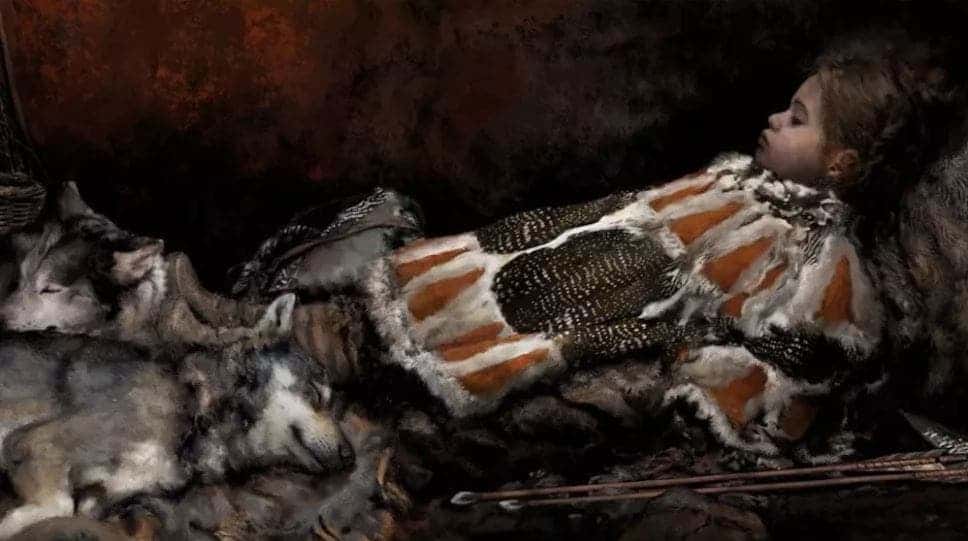A surprising find in Finland is giving us a unique glimpse into the area’s Stone Age peoples. The discovery consists of a burial site holding the remains of a child alongside grave goods, bird feathers, canine fur, and plant fibers.

What sets this site apart is the extremely good conservation state of the furs and feathers in the gravesite compared to other findings in Finland. Finland’s soils are, overall, highly acidic, rapidly degrading any organic material buried within.
The findings help give us a unique glimpse into the burial practices of Stone Age peoples that lived in the lands of today’s eastern Finland. The site was discovered by chance based on the presence of red ochre, an iron-rich soil that is heavily associated with burial sites and rock art, which had stained a gravel roadway near the town of Outokumpu.
Ancient burial
“The work is really slow and it really made my heart jump when I found minuscule fragments of past garments and grave furnishings, especially in Finland, where all unburnt bones tend to decompose,” study lead author Tuija Kirkinen, a postdoctoral researcher in the Department of Cultures at the University of Helsinki, told CNN(opens in new tab). “This all gives us a very valuable insight about burial habits in the Stone Age, indicating how people had prepared the child for the journey after death.”
The site was first discovered in 1991 in Majoonsuo, a site near the town of Outokumpu in eastern Finland, by archaeologists from the Finnish Heritage Agency (FHA). The grave contained the teeth of a child who is estimated, based on dental analysis, to have died between the ages of 3 and 10 years old. Based on follow-up examinations at the site in 2018, the FHA determined that it was “at risk of destruction”, prompting its excavation.
The site was dated back to the Mesolithic — Middle Stone Age — period based on the shape of two quartz arrowheads found within. This would mean that the grave was dug around 8,000 years ago. In soil samples retrieved from the site, the team discovered the barbules of waterfowl feathers — feathers that they believe were used to create a bedding for the child to lay on. A single fragment of a feather determined to have originated from a falcon was also found. This may have been the fletching in an arrow, or, alternatively, could have been decoration on a piece of clothing.
Apart from these pieces of feathers, the team also discovered 24 fragments of mammalian fur at the base of the burial pit. Many of these were heavily degraded, but at least three were sufficiently preserved to allow identification. According to the team, these pieces of fur came from a canine such as a wolf or a dog. This animal was likely laid at the feet of the child as part of the burial ritual. That being said, the team is not ruling out the possibility that these hairs came from clothing such as footwear, which could have been fashioned from dog or wolf skin.
“Dogs interred with the deceased have been found in, for example, Skateholm, a famous burial site in southern Sweden dating back some 7,000 years,” Kristiina Mannermaa, a researcher and associate professor in the Department of Cultures at the University of Helsinki, said in the statement. “The discovery in Majoonsuo is sensational, even though there is nothing but hairs left of the animal or animals — not even teeth. We don’t even know whether it’s a dog or a wolf.”
“The method used demonstrates that traces of fur and feathers can be found even in graves several thousands of years old, including in Finland.”
Finally, the plant fibers found at the site came from willow and nettles. Such fibers were likely used to make clothing or specialized equipment such as fishing nets.
The treasure trove of data that archeologists have been able to recover from this site will go a long way to furthering our understanding of Mesolithic burial practices in this area. They also help us better understand how locals approached the manufacture of various goods such as clothing or tools.
Such data is especially important as this area of Finland has, so far, yielded precious little archeological evidence due to the chemical nature of its soils. The team explains that it is very surprising to see organic material being so well preserved over the centuries in the highly acidic soils of the area.
The paper “Preservation of microscopic fur, feather, and bast fibers in the Mesolithic ochre grave of Majoonsuo, Eastern Finland” has been published in the journal PLOS One.









